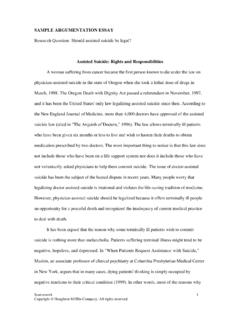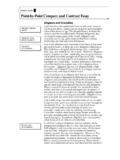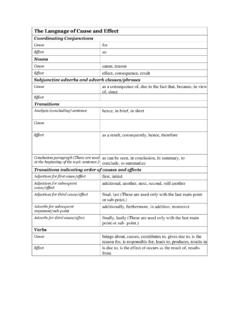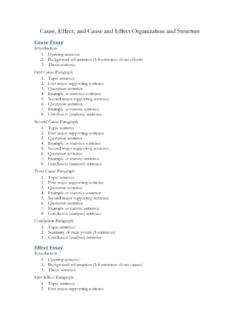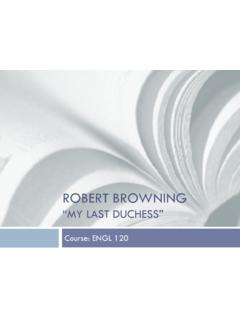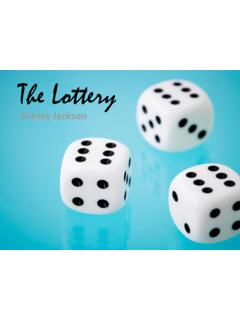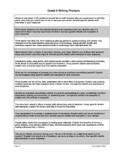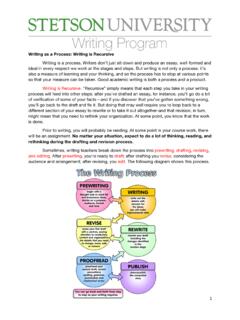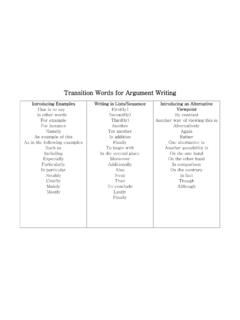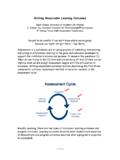Transcription of Writing a Counterargument and Refutation
1 Writing a Counterargument and Refutation Counterargument The Counterargument paragraph is developed in much the same way that an argument paragraph is developed. The difference is that the Counterargument is your opponents' (the other side's) argument that explains why you are wrong. This paragraph is structured as follows: 1. Topic sentence. It states the other side's reason for why you are wrong. Nouns used in this sentence are critics and opponents. Verbs used in this sentence are argue , claim, and contend. Pattern 1. Transition + some critics / opponents + argue / claim + that + argument against your thesis. Nevertheless, some critics argue that the reason why some terminally ill patients wish to commit suicide is nothing more than melancholia. Pattern 2. Transition + it is argued that + argument against your thesis.
2 Nevertheless, it is argued that the reason why some terminally ill patients wish to commit suicide is nothing more than melancholia. 2. Explanation sentence. It explains the controlling idea, the topic sentence. 3. Expert evidence sentence. This sentence backs up the topic sentence with a quotation or paraphrase of evidence from expert(s). It includes the name of the author, name of the article, and the date of publication. 4. Explanation sentence. It explains the supporting evidence from expert(s). 5. Example and / or statistics sentence. This sentence contains an example or statistics that support the evidence from the expert(s). 6. Explanation sentence. It explains the significance of the examples or statistics as related to the controlling idea, the thesis sentence. 7. Conclusion sentence. It states what conclusion can be made once people consider the controlling idea and evidence.
3 Directions: After reading the sample Counterargument paragraph below, answer the questions that follow it. Critics argue that the reason why some terminally ill patients wish to commit suicide is nothing more than melancholia. Patients suffering terminal illness might tend to be negative, hopeless, and depressed. In "When Patients Request Assistance with Suicide," Dr. Michael Maskin, an associate professor of clinical psychiatry at Columbia- Presbyterian Medical Center in New York, argues that in many cases, dying patients'. thinking is simply occupied by negative reactions to their critical condition (1999). In other words, most of the reasons why terminally ill patients request doctors to assist them in committing suicide might be caused by certain problems related to their illness. For example, they may be experiencing problems such as hopelessness because there is no effective treatment, anxiety over doctors' very expensive fees, and regret for their family's burden of taking care of them (Maskin, 1999).
4 For this reason, opponents argue that the terminally ill patient needs psychotherapy. Therefore, people who oppose doctor-assisted suicide believe that these patients are much too depressed to make a logical decision. Adapted from student handout, Sourcework, Heinle & Heinle, 2006. 1. What is this paragraph about? 2. Who is the expert? 3. What is the name of the article that the expert's opinion is taken from? 4. When was this article published? 5. What does the expert argue ? 6. What examples are used to support the expert's opinion? 7. Based on the examples, what do the critics argue that dying people need? 8. What conclusion is reached? Refutation The Refutation paragraph must prove that your opponents' objection ( Counterargument ) is wrong. To do this, you must answer the objection in a fair and logical manner.
5 This paragraph is structured as follows: 1. Opening sentence. It summarizes the other side's objection and acknowledges the 2. validity of the objection. This sentence must contain the modal may. Pattern It may be true that + paraphrase of objection. It may be true that all such requests, in which dying patients ask doctors to help them to kill themselves, come from depression as some psychologists have claimed and that some patients will change their minds if they participate in psychotherapy. 2. Topic sentence. It states the reason why the objection ( Counterargument ) is wrong. It is introduced by a transition such as however, nevertheless, or nonetheless. Pattern Transition + reason why the objection is wrong. However, all of those terminally ill patients who after psychotherapy finally choose to hasten their deaths are very determined.
6 3. Expert evidence sentence. This sentence backs up the topic sentence with a quotation or paraphrase of evidence from expert(s). It includes the name of the author, name of the article, and the date of publication. 4. Explanation sentence. It explains the supporting evidence from expert(s). 5. Example and / or statistics sentence. This sentence contains an example or statistics that support the evidence from the expert(s). 6. Explanation sentence. It explains the significance of the examples or statistics as related to the controlling idea, the thesis sentence. 7. Conclusion sentence. It states what conclusion can be made once people consider the controlling idea and evidence. Directions: After reading the sample Counterargument paragraph below, answer the questions that follow it. It may be true that all such requests, in which dying patients ask doctors to help them to kill themselves, come from depression as some psychologists have claimed and that some patients will change their minds if they participate in psychotherapy.
7 However, all of those terminally ill patients who after psychotherapy finally choose to hasten their deaths are very determined. In "Opposing Views on Assisted Suicide," Faye Girsh points 3. out that many dying patients want to know about how to get help from a doctor to achieve a peaceful death even if ultimately they do not choose suicide (1999). In other words, terminally ill patients who voluntarily choose to ask doctors to help them commit suicide are those who decide carefully to take advantage of the doctor-assisted suicide law. For example, Girsh states that patients who consider assisted suicide are aware of their exact medical condition through a mutual exchange of information with their doctors, these patients understand their medical treatment along with risk, benefits and other options, and they must talk with a psychologist to determine if they are psychologically able to make such a decision (1999).
8 These are not patients who want to end their lives simply because they are depressed. In short, terminally ill patients who finally choose to ask doctors to help them commit suicide are mentally competent and very determined about what they want to choose. Adapted from student handout, Sourcework, Heinle & Heinle, 2006. 1. Does the writer acknowledge the validity of the other side's objection? 2. Why is the objection wrong? 3. Who is the expert? 4. What is the name of the article that the expert's opinion is taken from? 5. When was this article published? 6. What does the expert argue ? 7. What examples are used to support the expert's opinion? 8. What does the example prove? 9. What conclusion is reached? 4.
